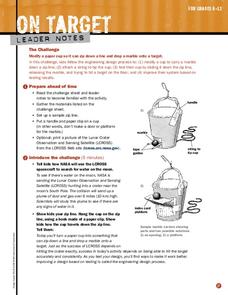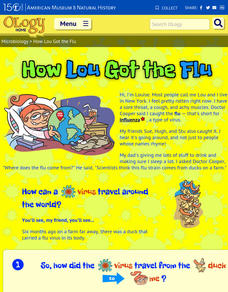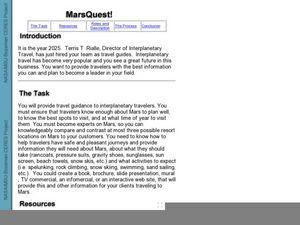Curated OER
Waves and Currents
Middle schoolers are introduced to the forces that are responsible for generating waves in the ocean and how these forcesf differ from those that cause currents. They are able to explain how water molecules in a wave do not move in the...
Curated OER
Evaporation Inquiry
The evaporation of water and what happens to it as it travels through the water cycle are the focuses of this lesson. The evaporation of water seems like a "magical" process to people of all ages. This lesson takes away the mystery, and...
Curated OER
Wagons West!
Through learning about the Oregon Trail and Nebraska, learners evaluate the elements of historical fiction. Coming with a comprehensive bibliography, this lesson has your class learn about settlers traveling along the Oregon Trail,...
Curated OER
Addition and Subtraction Numbers Trail Worksheet
The number four is going on an adventure! This is a fun take on addition and subtraction problems; learners begin this math maze with the number four, and take it through various operations at each box. As it travels, scholars write down...
Curated OER
Feel the Vibrations
How does sound travel in a string walkie-talkie? Third graders read about the way vibrations act between two cups and a string. Next, they put the steps in order, and experiment with their own walkie-talkies.
National Wildlife Federation
Massive Migrations
Turn your students into flocks of migratory birds for this fun activity on animal migration. Prior to the activity, the teacher creates four different migration routes in the classroom or any available open space, labeling nesting...
Positively Autism
Thanksgiving Verbs
Bake, cook, eat, serve, travel. Five verbs associated with Thanksgiving are introduced to learners with autism. This is a presentation that features one printed word and an illustration of that word on each slide.
Curated OER
Drive the Data Derby
Three days of race car design and driving through the classroom while guessing probability could be a third graders dream. Learn to record car speed, distances traveled, and statistics by using calculation ranges using the mean, median,...
Curated OER
Earthquakes: Third Grade Lesson Plans and Activities
Introduce third graders to energy waves with a hands-on geology activity, in which they answer questions and compare seismograms in the San Francisco Bay area. After a demonstration that shows how bigger waves indicate a high-intensity...
NASA
On Target
NASA's LCROSS mission is dropping a probe into a lunar crater. Groups design a system to travel down a zip line and drop a marble onto a target in the classroom. The groups then modify their designs based upon testing.
Columbus City Schools
Earthly Waves
How did scientists discover what lies beneath the earth's surface? Dig a hole? X-ray vision? Guide your class through the types of seismic waves and how these waves helped shed light on Earth's many layers. The included resources provide...
DiscoverE
Design a Folding Solar Panel
Solar energy is an amazing alternative ... but, not always particularly portable! Challenge young scientists to a folding solar panel build-off with an easy-to-execute activity. Scholars brainstorm around specific design needs, construct...
DiscoverE
Puff Mobiles
You've probably heard of solar-powered cars, but what about wind-powered cars? Scholars build cars that can travel at least six feet. They can only use their breath to move the car—so, obviously, a sail might be a good feature for the...
Centers for Disease Control and Prevention
Going SmokeFree Matters: In Your Home
Is secondhand smoke avoidable if you live with a smoker? Pupils look over an infographic to learn more about how secondhand smoke can travel throughout several rooms, who is more likely to be affected by smoke, and what health conditions...
101 Questions
Pokémon Go Cheat
Gotta catch them all—no learner left behind! Young scholars must predict the length of time it takes a phone attached to a fan to travel five kilometers given the radius and rotations versus time data. Why would you attach a phone to a...
American Museum of Natural History
Sounds of the Silk Road
Young explorers may not be able to travel the Silk Road but they can listen to music that was played on instruments of the time and create their own songs with the help of an interesting interactive resource.
American Museum of Natural History
How Lou Got the Flu
Six questions probe participants to discover the possibility of catching a virus from others—even animals. Here, the influenza virus travels from duck to person in a round-about way. The quiz concludes with helpful tips to stay healthy.
Curated OER
Just How Big is this Place?
Students are introduced to the the formula for calculating travel time. They listen to different scenarios relating to long distance travel into space and calculate travel time using the formula.
Curated OER
Exploring and Comparing Other Communities
Third graders search TDC database for images of physical geography maps, weather maps, natural resources maps, and old travel brochures. They create a new travel brochure of an area of their choice using the information they gathered.
Curated OER
Charting The Progress of New Horizons
Students explore the long distances and timescales involved in space travel. They track the progress of the New Horizons spacecraft and access the New Horizons website to discover the distance of the spacecraft from the Sun, and then...
Curated OER
Marsquest
Students play a role as a travel guide to Mars, they are broken up into groups or different roles. In this exploratory lesson students play a role in helping travelers to Mars and create some kind of presentation, for example a...
Curated OER
Europe Project: Let’s Take a Trip
Seventh graders travel to Europe. In this research skills lesson, 7th graders plan trips to Europe that include details about the places they will visit, how much the trip will cost, and the cultural experiences they think they will...
Curated OER
Unique Landforms
Students create a travel route among different landforms and way the cost and benefits of traveling this way. In this traveling lesson plan, students work in groups and analyze their conclusions.
Curated OER
Planet Vacation
In this planets worksheet, students fill out a chart where they fill in the distance each planet is from the Earth, and how much travel time in years and hours it would take to get there. Students do this for 8 planets.
Other popular searches
- Space Travel
- Space Exploration
- Travel Brochure
- Travel and Tourism
- Time Travel
- Pros Cons Space Exploration
- Creating a Travel Brochure
- Space Travel Brochure
- Travel Math
- Air Travel
- Space Exploration Timeline
- China Travel Brochure

























